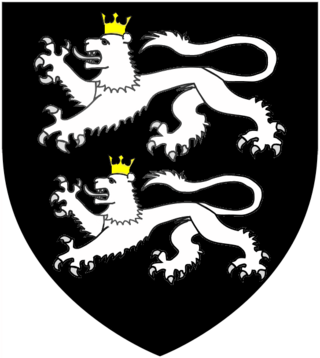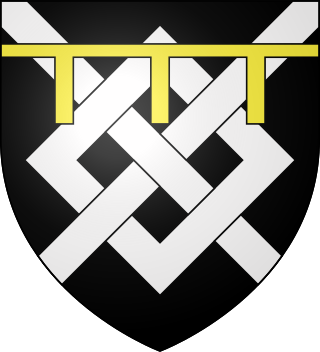Related Research Articles

The Battle of Bosworth or Bosworth Field was the last significant battle of the Wars of the Roses, the civil war between the houses of Lancaster and York that extended across England in the latter half of the 15th century. Fought on 22 August 1485, the battle was won by an alliance of Lancastrians and disaffected Yorkists. Their leader Henry Tudor, Earl of Richmond, became the first English monarch of the Tudor dynasty by his victory and subsequent marriage to a Yorkist princess. His opponent Richard III, the last king of the House of York, was killed during the battle, the last English monarch to die in combat. Historians consider Bosworth Field to mark the end of the Plantagenet dynasty, making it one of the defining moments of English history.

Edward IV was King of England from 4 March 1461 to 3 October 1470, then again from 11 April 1471 until his death in 1483. He was a central figure in the Wars of the Roses, a series of civil wars in England fought between the Yorkist and Lancastrian factions between 1455 and 1487.

John Howard, 1st Duke of Norfolk, also known as Jack of Norfolk,, was an English nobleman, soldier, politician, and the first Howard Duke of Norfolk. He was a close friend and loyal supporter of King Richard III, with whom he was slain at the Battle of Bosworth in 1485.
Sir Robert Brackenbury was an English courtier, who was Constable of the Tower of London during the reign of Richard III. He is believed to have been responsible for enabling the (presumed) murders of the Princes in the Tower, though there is no conclusive evidence to prove it. He died defending the King at the Battle of Bosworth Field in 1485.

Henry Percy, 4th Earl of NorthumberlandKG was an English aristocrat during the Wars of the Roses. After losing his title when his father was killed fighting the Yorkists, he later regained his position. He led the rearguard of Richard III's army at the Battle of Bosworth, but failed to commit his troops. He was briefly imprisoned by Henry VII, but later restored to his position. A few years later he was murdered by citizens of York during a revolt against Henry VII's taxation.

Sir William Brandon of Soham, Cambridgeshire was Henry Tudor's standard-bearer at the Battle of Bosworth, where he was killed by King Richard III. He was the father of Charles Brandon, 1st Duke of Suffolk.

Nicholas Vaux, 1st Baron Vaux of Harrowden was a soldier and courtier in England and an early member of the House of Commons. He was the son of Lancastrian loyalists Sir William Vaux of Harrowden and Katherine Penyson, a lady of the household of Queen Margaret of Anjou, wife of the Lancastrian king, Henry VI of England. Katherine was a daughter of Gregorio Panizzone of Courticelle, in Piedmont, Italy which was at that time subject to King René of Anjou, father of Queen Margaret of Anjou, as ruler of Provence. He grew up during the years of Yorkist rule and later served under the founder of the Tudor dynasty, Henry VII.

The Honourable The King's Champion is an honorary and hereditary office in the Royal Household of the British sovereign. The champion's original role at the coronation of a British monarch was to challenge anyone who contested the new monarch's entitlement to the throne to trial by combat. Although this function was last enacted at the coronation of George IV in 1821, the office continues to descend through the Dymoke family.

Peter Courtenay was Bishop of Exeter (1478–87) and Bishop of Winchester (1487-92), and also had a successful political career during the tumultuous years of the Wars of the Roses.

The Dymoke family of the Manor of Scrivelsby in the parish of Horncastle in Lincolnshire holds the feudal hereditary office of King's Champion. The functions of the Champion are to ride into Westminster Hall at the coronation banquet and challenge all comers who might impugn the King's title.

Walter Devereux, 8th Baron Ferrers of Chartley, KG was an English nobleman and a loyal supporter of the House of York during the Wars of the Roses. He was a member of the inner circle of King Edward IV, and died fighting for Edward's younger brother, King Richard III, at the Battle of Bosworth in 1485.

Sir John Courtenay was the third son of Thomas Courtenay, 13th Earl of Devon, and Margaret Beaufort, and was styled Earl of Devon by Lancastrians in exile, following the execution of his brother the 14th earl in 1461.
Sir Anthony Browne was the son of Sir Thomas Browne and Eleanor FitzAlan. He served as standard-bearer to Henry VII, and Lieutenant of Calais.
Sir William Norreys was a famous Lancastrian soldier, and later an Esquire of the Body to King Edward IV.
Ralph Neville, 3rd Earl of Westmorland was an English peer. He was the grandfather of Ralph Neville, 4th Earl of Westmorland.

Sir David Mathew, was a Welsh Knight. He was Lord of Llandaff and Seneschal of Llandaff Cathedral, and one of the ten Great Barons of Glamorgan, a Marcher Lord. It was said he was one of the most distinguished men of his age and a zealous supporter of the Yorkist cause. After saving the life of King Edward IV at the Battle of Towton in 1461, he was appointed Grand Standard Bearer of England and King Edward IV granted the use of 'Towton' on his arms.
Richard Welles, 7th Baron Welles (c.1428–1470), was an English nobleman and soldier. From a Lancastrian family, he came to be on good terms with the Yorkist King Edward IV, but was later executed after being associated with a plot against Edward known as the "Welles Uprising".
Humphrey Dacre, 1st Baron Dacre of Gilsland, was an English soldier, Cumberland landowner and peer.

Sir James Harrington of Hornby was an English politician and soldier who was a prominent Yorkist supporter in Northern England during the Wars of the Roses, having been retained by Richard Neville, 5th Earl of Salisbury, who was brother-in-law to the head of the House of York, Richard of York. He was the second son of Sir Thomas Harrington, who had died with the king's father at the Battle of Wakefield in December 1460. James himself had fought with Salisbury at the Battle of Blore Heath in 1459, where he had been captured and imprisoned by the Lancastrians until the next year. He was a significant regional figure during the reign of King Edward IV, although the early years of the new king's reign were marred by a bitter feud between him and the Stanley family over a castle in Lancashire. On the accession of King Richard III in 1483, he was appointed to the new king's Household, and as such was almost certainly with him at the Battle of Bosworth Field two years later. It is likely that he fell in battle there, although precise details of his death are now unknown.

Sir Henry Vernon, KB, was a Tudor-era English landowner, politician, and courtier. He was the Controller of the household of Arthur, Prince of Wales, eldest son of Henry VII of England and heir to the throne until his untimely death.
References
- Burke, John (1847), Burke's Genealogical and Heraldic History of the Landed Gentry, vol. 2, H. Colburn, p. 844